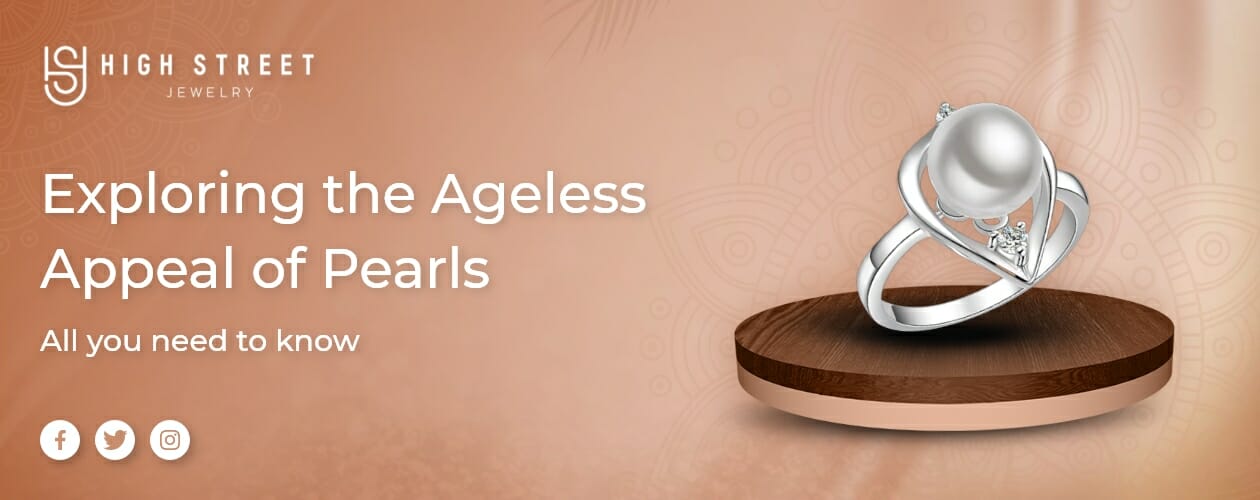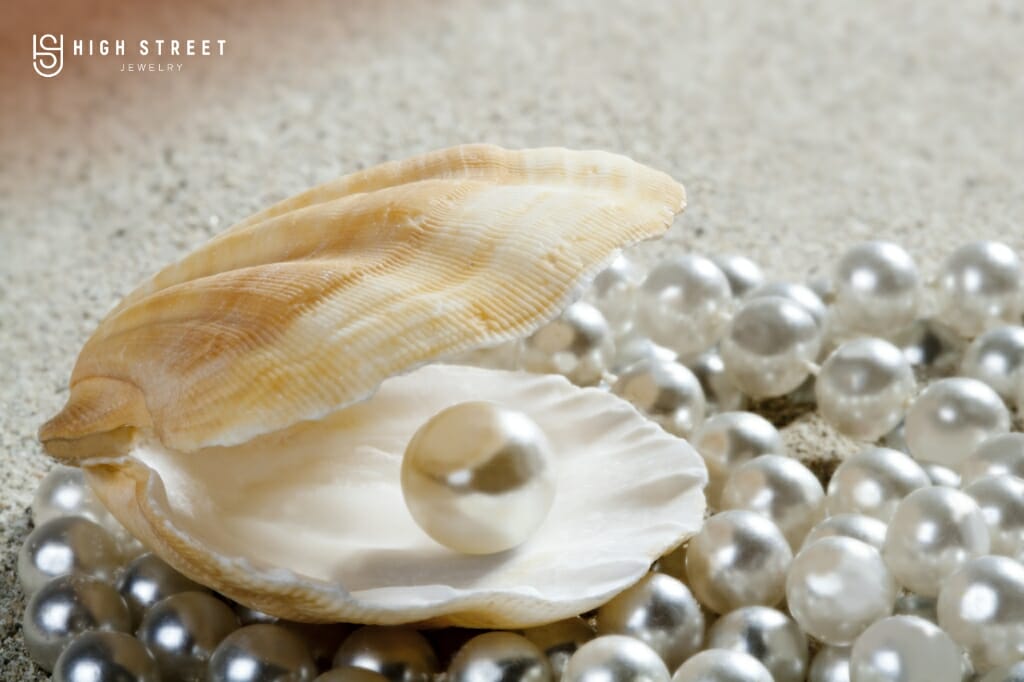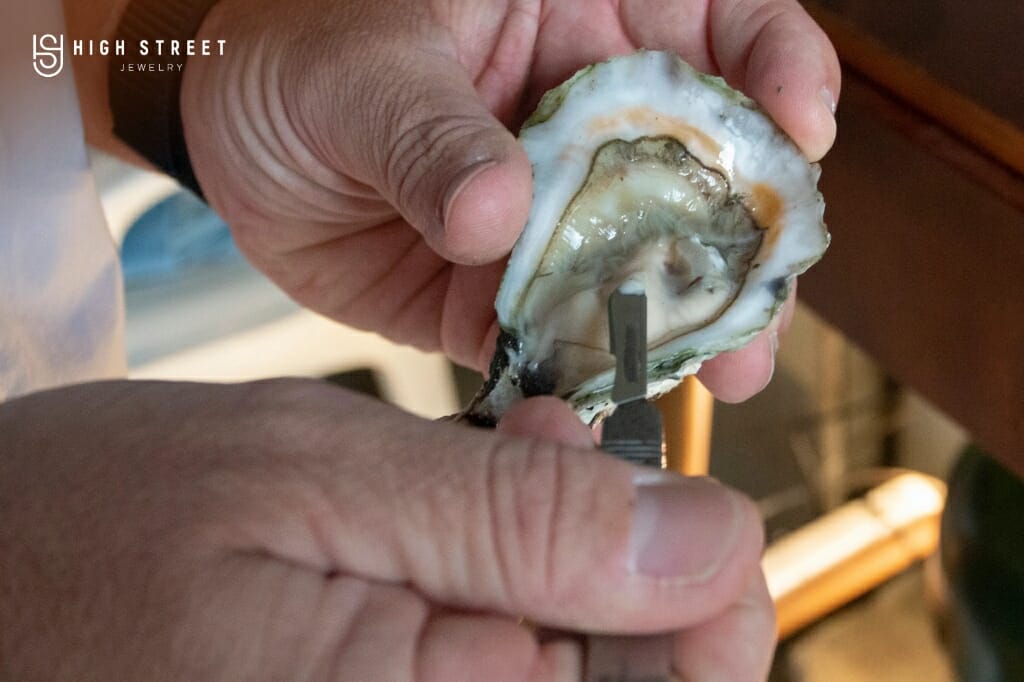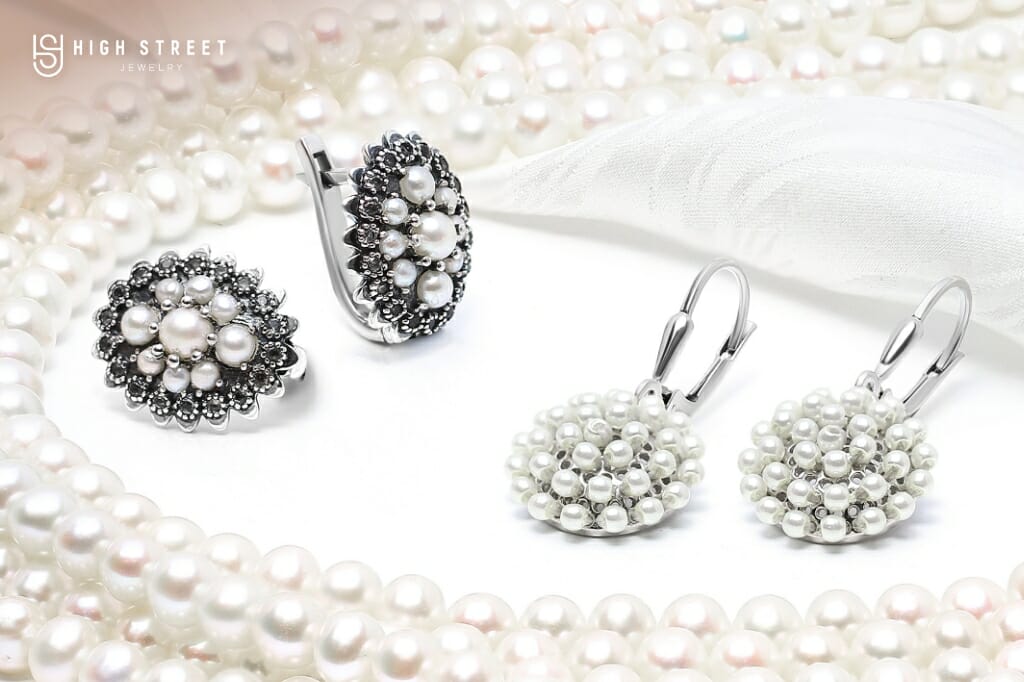Any discussion on jewelry is lackluster without the mention of shiny, shimmery pearls. A pearl necklace is the cynosure of every eye, its serene pristine dazzle enough to take the attention off the brightest jewel in the store. The timeless radiance of pearls has cascaded from ancient times to glitzy runaways of contemporary fashion.
These gems have graced the necks and wrists of empresses and queens and complemented the finest garments of Hollywood’s most iconic stars. From the regal grace of Audrey Hepburn to the polished demeanor of confident Hillary Clinton, pearls have been the trusted jewelry of choice for icons the world over.
Also, pearls are not merely jewelry; they are the timeless classical gem passed down through generations and are as old as water.
Wait, don’t leave already; we have more! Join us to uncover some super interesting facts about “Pearls” as we proceed with this article.
What is a pearl?
The term pearl refers to a broad range of natural things, including snail shells and mussel shells. The name “pearl” can also apply to artificial pearl-like things like glass beads. When most people say “pearl,” they’re referring to a specific style of jewelry: a pearl necklace or earrings.
A pearl is like a tiny, round treasure created by particular sea creatures. Chemically composed of calcium carbonate, which lends it the hardness, think of it as a little ball covered in a shiny coating. As we will see later, pearls are categorized as natural and cultured.
History of pearls – the enduring enigma
For millennia, pearls have been coveted for their beauty and scarcity. Around 2,500 BC, natural pearls were first collected from the Persian Gulf and soon became synonymous with aristocracy and opulence.
Let’s look into the history of wearing pearls. We discover cultures from all over the world – including Romans, Egyptians, Chinese, Indians, Greeks, and Europeans treasured pearls and exchanged them as gifts between families and for strengthening diplomatic ties.
Only ruling class members were permitted to wear pearls in ancient Rome. Pearls were believed to have magical qualities in China, and they were frequently presented as wedding presents or worn as talismans to fend off evil spirits.
It would also surprise you when we tell you the pearling industry in UAE predates the prosperity brought by the oil economy. It was a flourishing trade that brought international recognition to the UAE.
An elaborate network of sea divers, their sponsors, enterprising merchants, buyers, and intermediaries who sold the world’s finest pearls, and many pearl merchants were of Persian and Indian origin.
The origin of pearls in nature’s lap
So, what triggers the pearl formation in the creature? When a pesky intruder gets inside the sea creature’s shell, it responds by producing that shiny stuff, nacre, to wrap around the annoyance and protect itself.
Now, ever since humans found how pearl formation takes place in nature, it led to the discovery of cultured pearls where instead of waiting for the process to happen, something is put inside the creature to start the pearl-making process.
So, whether made by nature or with a bit of human touch, pearls are these lovely, shiny balls from the ocean!
Process of natural pearl formation
Their beauty comes from their gentle internal glow and iridescence, a natural gift that does not need to be enhanced.
- Irritant Entry: This occurs when an irritant, such as a sand grain or a parasite, penetrates the oyster or mollusk.
- Nacre Formation: To shield itself from the irritant, the oyster releases a material known as nacre (or mother-of-pearl) around itself. Nacre comprises several layers of calcium carbonate crystals that form over time.
- Layering: The oyster secretes nacre in layers, gradually covering the irritant. This stacking process leads to the development of a pearl over time.
- Natural Variation: Natural pearls can vary in form, size, and color depending on the mollusk species and environmental circumstances. They are frequently uneven in form and may contain flaws.
- Rarity: Natural pearls are extremely uncommon and costly because of their unexpected and time-consuming creation process.
- Harvesting: Divers used to harvest natural pearls from the ocean floor in the past. However, this activity has become rare because of excessive harvesting pollution and dwindling numbers of pearl-producing mollusks.
The rarity of natural pearls
Natural pearls have fallen out in recent times. Natural pearls are scarce and develop in both freshwater as well as saltwater. Only a tiny percentage of mollusks produce gem-quality, spherical, blemish-free pearls, making them extremely rare.
Natural pearls cannot be made and are determined by location, oceanic conditions, and ancestral lineage. It was natural to look for options.
Consequently, we entered the era of cultured or farmed pearls, with Japan being the pioneer, which meets the demands of the jewelry industry. There are different kinds of pearls today.
They come in various shapes and sizes, each with unique beauty and charm. However, there is still some debate regarding what qualifies as a “natural ” pearl.
However, finding the right pearl might take time, considering the plethora of options on the market.
How to recognize a natural pearl?
Natural pearls have thicker nacre or “skin” than produced pearls. A pearl with a thick nacre will reveal concentric growth lines when held up to a strong light source, indicating that each successive layer of nacre was created throughout time, as mentioned above.
Cultured pearls- farming to meet demands
As informed earlier, cultured pearls are produced in a regulated method in which an irritant is injected into oysters or mussels, allowing cultivators optimal development and lighting.
They are similar to genuine pearls but mature faster, requiring roughly three years instead of seven years of development for natural pearls. There are as many as nine types of pearls widely recognized.
Akoya pearls, recognized for their circularity, smooth shape, and brightness, are popular and primarily farmed in Japan and China.
Tahitian pearls are naturally black and farmed in French Polynesia, but South Sea pearls are valued for their size and illumination and originated from Indonesia, the Philippines, Australia, and Myanmar.
Freshwater pearls, cultivated in areas like China, have pastel colors and are less expensive than saltwater pearls. Luisa Village in China is a prominent pearl growing center, generating many of the world’s pearls.
Saltwater pearls are more expensive than cultured freshwater pearls. By the time a saltwater oyster produces one pearl, a freshwater mussel will bring up some 30 pearls.
The most expensive pearls are often South Sea pearls and superior Tahitian pearls, recognized for their size, brilliance, and unusual hues. Akoya pearls are likewise of exceptional grade and may be pretty costly.
Most popular pearl jewelry
Pearls are a popular option for jewelry since they are ageless and traditional. Pearl jewelry comes in various styles, from modest and delicate pieces to dramatic and statement-making designs. Here are some of the several varieties of pearl jewelry available:
Necklaces made of pearls
Pearl necklaces are the most common type of pearl jewelry. They are available in a wide range of lengths, designs, and colors, from modest single-strand necklaces to more ornate multi-strand and choker versions.
Earrings with pearls
Pearl earrings are a classic complement to any jewelry collection. They are available in various designs, including studs, hoops, and drops, and may be worn with both informal and formal clothes.
Pearl necklaces and their variations
A pearl necklace is a show-stealer. It wins hands-down when it comes to any occasion. Here are some examples of different types of pearl necklaces.
- Single Strand Pearl Necklace: A single strand of pearls, frequently of uniform size and shape, is used in this traditional style. It’s a flexible item that goes with both informal and formal outfits.
- Multistrand Pearl Necklace: Multistrand pearl necklaces are made up of two or more strands of pearls that are sometimes piled for a more dramatic and sumptuous look. They offer a luxurious touch to every ensemble.
- Choker Necklace: A choker necklace is a single strand of pearls that sits tight to the neck. They are popular for formal occasions and may create an impressive statement piece.
- Matinee Necklace: A matinee necklace is longer than a choker but shorter than an opera necklace. It usually falls slightly above the breast line, making it suitable for business and formal use.
- Opera Necklace: Longer necklaces, generally 26 to 36 inches long, can be worn as a single strand or doubled for a layered effect. They are flexible and may be worn with a wide range of necklines.
- Tin Cup Necklace: Tin cup necklaces are made up of pearls placed at regular intervals along a chain and typically have little gemstone embellishments. This design has a delicate and sophisticated appeal that is ideal for everyday use.
- Baroque Pearl Necklace: Because baroque pearls are uneven in shape, each one is unique. A baroque pearl necklace highlights the natural beauty of these pearls, giving a touch of organic appeal to your jewelry collection.
- South Sea Pearl Necklace: The pearls from the South Seas are prized for their size and luster. South Sea pearl necklaces are opulent and highly valued for their exquisite quality and uniqueness.
- Tahitian Pearl Necklace: Tahitian pearls are well-known for their dark, exotic hues. A Tahitian pearl necklace provides a striking and exquisite aesthetic with rich colors ranging from black to gray to peacock green.
- Necklace with Akoya Pearls: Akoya pearls are known for their round form and superb brilliance. The pearls are an increasingly common option for sophisticated, traditional, and timeless necklaces.
- Freshwater Pearl Necklace: The pearls from freshwater are often less expensive than other sorts and are available in a variety of shapes and hues. A freshwater pearl necklace is versatile and beautiful without being expensive.
Buying pearl jewelry- get the right one
With a mind-boggling range of colors and kinds, you would be in a fix. The obvious question would be – How to buy pearls? Unless you are willing to pay handsomely for a natural pearl, most pearls used today are cultured pearls.
We are equipping you with the knowledge to separate a real pearl from a fake one. It is always good to have some background information before hitting the store.
Identifying real and fake pearl
To buy a pearl, you must understand how to tell the difference between a genuine and a fake one. Here are some pointers to get you started:
- Examine the pearl’s surface- Tiny irregularities are fine. Also, cultured and natural pearls respond differently when put under light under examination.
- Rub it to get the surface feel- Fake ones feel unnaturally smooth. This is also called the “tooth test,” where the pearl is rubbed against one’s tooth. Real ones feel sandy and a bit rough.
- Examine the product for flaws- Uniform colors or pearls lacking depth are usually fake. However, put the pearls to other tests too.
- Examine the form of the pearls- Most real pearls are rarely round; mostly oval, button, near-round, circled, coin, drop. Machine-made pearls are too identical.
- Take note of the pearl’s weight- Real pearls are usually heavier than fake ones.
- Examine the drill holes- usually very small in natural pearls but bigger in imitation pearls.
- The vinegar test- where the real pearl dissolves or gets damaged while the fake one survives. It is not highly recommended.
Must-do before buying
- Select the appropriate pearl kind.
- Choose the ideal size.
- Choose the appropriate necklace length.
- Consider your budget.
- Visit a reputed seller.
You should know pearl types and quality, different shapes of pearls, and types of pearls colors.
Also, consider seven factors to judge a pearl’s quality: luster, size, shape, color, surface, nacre quality, and matching.
Pearls sizes are usually measured in diameter, and the average cultured pearls sold today have a 7- 7.5 mm diameter. A larger-sized pearl will command more value.
Caring for your pearl jewelry
If you’re fortunate enough to own pearl jewelry, it’s crucial to care for it to ensure its longevity for generations to come. Here are some helpful tips and techniques for maintaining the beauty of your pearls;
- Store your pearls in a dry place from direct sunlight to preserve their luster.
- Keep your pearls in a soft cloth pouch, chamois bag, or jewelry box lined with gentle felt when not used.
- Avoid exposing your pearls to chemicals, cosmetics, or perfumes, as they can cause damage.
- Thinking about how to clean silver without damaging pearls? Use a non-ammonia-based cleaning solution safe for pearls, silver, and other delicate gemstones.
- The best way to clean freshwater pearls is to gently wipe them with lukewarm water and a few drops of mild detergent or dish soap. This also serves as the answer to how to clean pearl jewelry.
- Do not hang your necklace to dry, which may elongate the strings. Always place your cultured pearls flat to dry.
- After each wearing, delicately wipe your pearls with a cloth to remove debris or oils.
- Consider having your precious pearls professionally cleaned every few years to maintain their stunning appearance.
- Also, get it re-stringed once every year. Ensure you are putting knots, so prevent losing pearls, in case your necklace snaps.
Remember that by handling and caring for your pearl jewelry, you can ensure its splendor lasts through the ages.
Pearls and silver jewelry- a hit pair
Few jewelry pairings are as enchanting and ageless as the marriage of pearls and silver. Pearls have been decorating jewelry for generations due to their glossy beauty and classic appeal while silver, with its moon-like soothing charm, provides the ideal backdrop for these sparkling gemstones.
Pearls are frequently utilized to make stunning and timeless pieces of silver jewelry. Here are a few ways pearls are commonly used in silver jewelry:
- Pearl Necklaces: Silver chains or strands are commonly coupled with pearl pendants or strung with pearls to produce classic pearl necklaces. Styles range from modest single-strand patterns to more intricate multi-strand or layered ones.
- Pearl Earrings: Whether in the shape of studs, dangle earrings, or hoops, silver is a popular choice for pearl earrings. The silver setting may enhance the pearl’s natural beauty while providing a secure setting.
- Pearl Bangles: Pearls can be used as charms, beads, or as the focal point of a silver pearl bangle. These bracelets can be delicate and feminine or hefty and aggressive, depending on the style. Or you can have pearl bracelets to jazz up your style.
- Pearl Rings: Pearls may be put in silver rings to make stunning and one-of-a-kind jewelry items. They can be utilized as focal points or as accent stones with jewels.
- Anklets with Pearls: Silver anklets with pearls are a fashionable accessory, especially when bare ankles are increasingly frequent in the summer.
With its extensive choice of silver jewelry collections, Highstreet Jewelry has introduced elegance to the daily routines of individuals in Dubai and worldwide.
We have some of the best pearl jewelry for various style statements and emotions. Allow your style to show through simply welcoming the pleasing aura of “Pearl” from Highstreet Jewelry.






